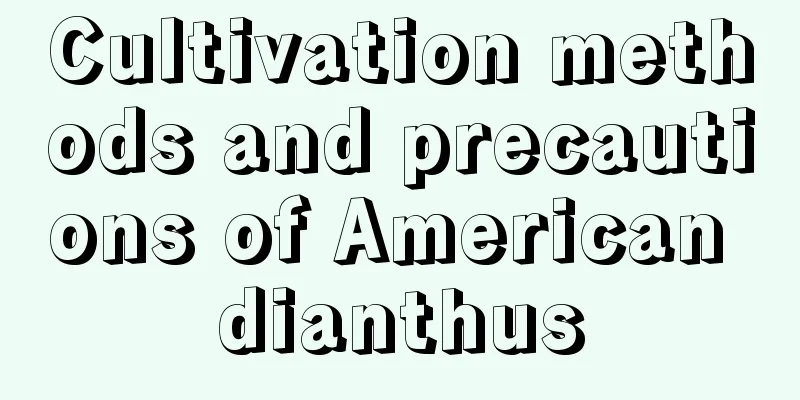Cultivation methods and precautions of American dianthus

1. Maintenance methods1. Light: It likes to stay in the sun, so be sure to give it enough sunlight. When the temperature is high, provide shade for it to avoid direct sunlight. 2. Temperature: The most suitable temperature is 15~20 degrees Celsius. When the temperature is high in summer, the temperature should be lowered. When the temperature is low in winter, it should be placed in a greenhouse and kept above 12 degrees Celsius. 3. Water: It does not require much water. You do not need to water it every day. Just water it when you see the soil is dry. 4. Nutrients: There is no need to fertilize frequently. Apply enough base fertilizer when planting. In the future, you only need to fertilize it at critical times such as when flower buds are formed. Generally, organic fertilizer is used. 2. Breeding techniques1. Wintering: It is afraid of cold. When the temperature is below 12 degrees Celsius in winter, it should be placed in a greenhouse. If there is sunshine, try to let it get more sun. 2. Sowing: Generally, sowing can be done in spring or autumn at around 20 degrees Celsius, because this temperature is most suitable for seed germination. Too high or too low temperature will inhibit germination. 3. Problem diagnosis and treatment1. Bacterial spot disease: Long gray-brown spots will appear on the leaves, rhizomes and petals. In severe cases, the leaves will turn yellow and fall off. If the disease is discovered, the humidity should be reduced in time and streptomycin sulfate should be sprayed for prevention and control. 2. Brown spot disease: Brown spot disease mainly harms its leaves, pedicels, and rhizomes. Circular spots appear in the early stage of the disease, and there are brown rings around the spots. When the disease is serious, the leaves dry up and the flowers wither. When the disease is found, spray benomyl in time. IV. Other issues1. Can it be given as a gift: It has a high ornamental value and is usually planted in flower beds. It can also be given as a gift to others. Planting two or three plants in a flowerpot will be more beautiful. 2. Is it poisonous? It is not poisonous, but as an ornamental plant, it is not suitable for eating and is very suitable for domestic cultivation. |
<<: Cultivation methods and precautions of raspberry
>>: Cultivation methods and precautions of beauty cherry
Recommend
The best way to raise fish in rice fields
Rice field fish farming is an ecological circular...
How many times a year can potatoes be planted in the South?
The climatic conditions in the southern region ar...
Is Chayote a Fruit or a Vegetable?
Is Chayote a fruit or a vegetable? Chayote is bot...
What to do if the roots of lucky bamboo in hydroponics turn black and smelly
One of the reasons why hydroponic roots turn blac...
The Flower Language and Legend of Amaryllis
Introduction to Amaryllis Name: Amaryllis Other n...
This kind of "water" can be made at home. Plants will grow rapidly when watered with it. It is much better than rice washing water!
Take the daily watering work for example. Many fl...
What should I do if the Clivia I have raised for 13 years has no roots? Just learn these few tricks!
The performance of empty roots If you discover th...
How to breed Rhododendron waxleaf
1. Planting Planting seeds is one of the ways she...
How to propagate yew by cuttings
How to propagate yew Yew can be propagated by sow...
Common Pests of Saxifraga and Their Control Methods
Common pests of saxifrage: mealybugs Pest symptom...
How to transplant yellow cicada
How to transplant yellow cicada Preparation Choos...
How much do you know about Feng Shui for growing flowers at home?
living room The living room should be more partic...
How often should I water the Kalanchoe in summer?
How often should Kalanchoe be watered in summer? ...
What is the difference between fragrant wood and pepper wood?
1. Different families These two plants belong to ...
What should I do if yam is infested with insects? What are the yam pests?
1. What to do if there are worms It is inevitable...









